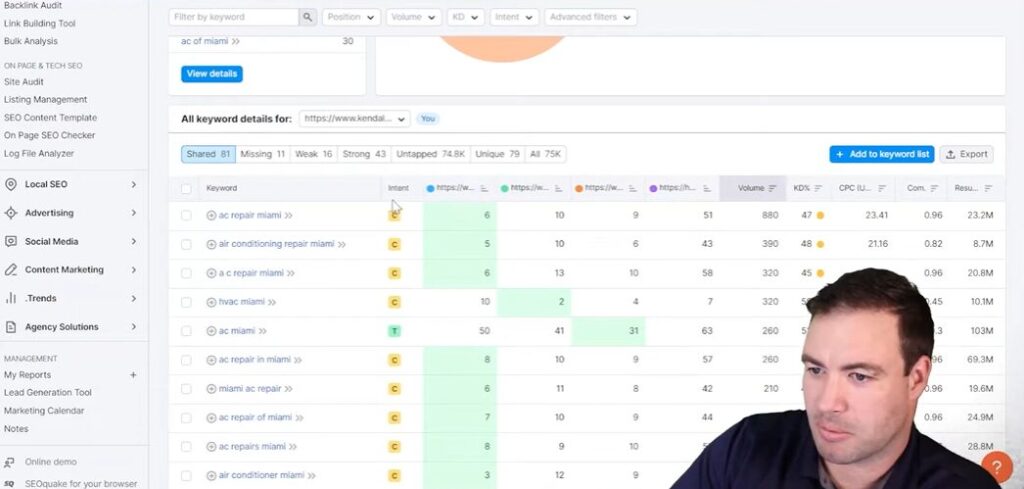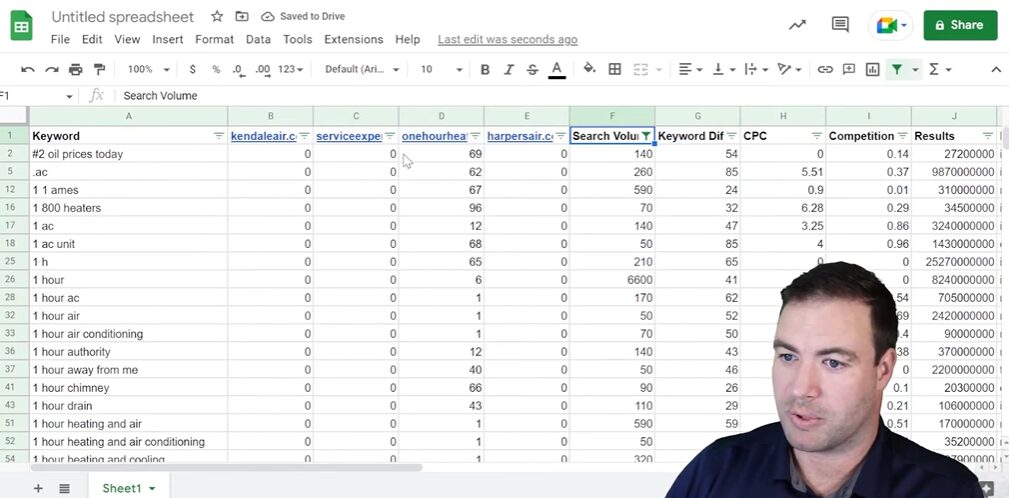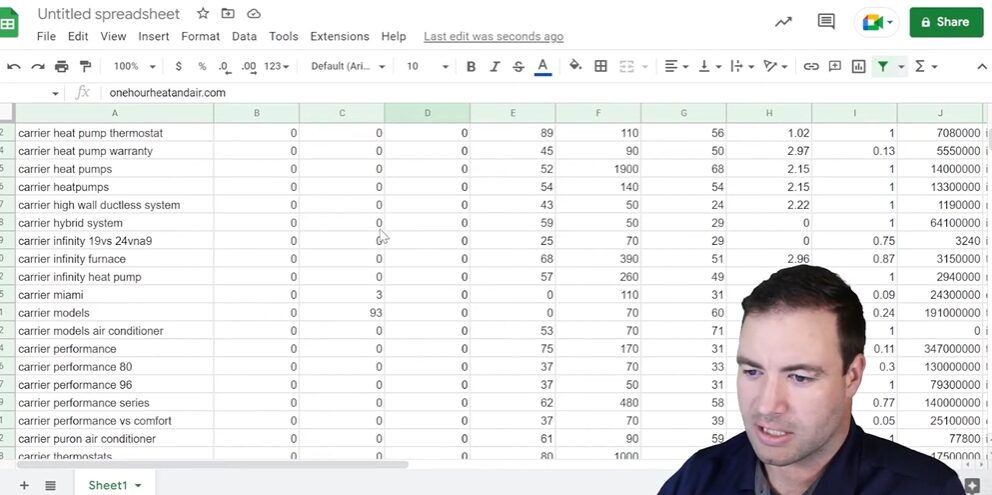Ever felt like you're chasing after the competition in your digital marketing efforts but can’t seem to catch up? I remember when I first started working in the HVAC industry, seeing bigger companies outshine us online felt demotivating. It wasn’t until I discovered keyword gap analysis that everything changed. Instead of merely scrambling to keep up, I learned how to strategically position our services to capture the attention we deserved. In this post, I’m excited to share the ins and outs of performing a keyword gap analysis using SEMrush - a game changer in my SEO strategy.
TL;DR: Learn how to perform a keyword gap analysis with SEMrush to uncover your competitors' strengths and identify opportunities for a more defined SEO strategy.
Table of Contents
What Is A Keyword Gap Analysis
A keyword gap analysis is an essential tool for anyone involved in SEO. So, what does it actually mean? In simple terms, it is a process of identifying valuable keywords that your competitors rank highly for. This way, we can find areas where we can improve our content strategy. Usually, it happens like a side-by-side comparison between keyword profiles of up to five competitors. It’s like peeking into the next guy’s playbook and applying those insights to our game.
Importance In SEO Strategy
Why is this analysis crucial? Well, first off, it allows us to refine our approach. Knowing what others rank for can uncover potential traffic sources we haven’t considered. Think about it: by understanding our competitors better, we can shape our SEO strategy more effectively.
- It highlights content gaps
- It showcases competitive advantages
- It helps prioritize keyword targeting
When we identify these gaps, we can focus on creating content that meets user demands. If we’re savvy about leveraging this tool, our site can climb the SERP quicker, attracting more visitors and potential customers. This is a sign to discover more about this SEO strategy that will surely help your website rank higher.
How It Helps Identify Content Opportunities
Let’s break this down further. Conducting a keyword gap analysis reveals content opportunities we might overlook. By analyzing competitors through a report in an organized analysis template, we spot keywords that pull in traffic to your website. This can lead us to create targeted articles tailored to our audience’s needs.
For example, a competitor might be performing well for a keyword like “best HVAC services in Miami.” By discovering this, we can develop content around that keyword and implement it into our website. It's what we call keyword research. This allows us to tap into existing demand.
Moreover, it’s not always about focusing on high-volume keywords. Sometimes, long-tail keywords with lower search volumes can present hidden gems. For instance, keywords with around fifty monthly searches might lead us to write a blog post that resonates with our target audience.
In summary, a keyword gap analysis is a game-changer for boosting our SEO efforts. It gives us clarity on content opportunities and helps shape our strategies to outshine our competitors.
Reviewing Domains With SEMrush

Navigating SEMrush Interface
When I first started using SEMrush, I was amazed by its user-friendly site interface. It's designed for everyone - whether you're a newbie or a seasoned pro. Navigation is straightforward, with clear categories and options laid out. You’ll find everything - from keyword analysis, keyword research to competitive analysis - just clicks away with this helpful tool.
Each section has intuitive buttons and tabs. That makes it easy to jump from one feature to another without getting lost. I like to think of it as wandering through a well-organized library, where finding your favorite book is a breeze.
Inputting Your Domain And Competitors
Let’s talk about the first step: inputting your domain. To get started, simply type your website’s address into the search bar at the top of the page. It’s like giving SEMrush the key to your digital house. The tool then fetches data about your site’s performance.
Next, you’ll want to analyze your competitors. For me, I always gather a list of competitors that are relevant to my niche. Avoid picking random websites; focus on those you truly compete with. After inputting their domains, SEMrush does its magic. You’ll get insights on keywords they rank for, their traffic, and more. It's like having a backstage pass to their success!
Understanding The Dashboard Layout
Once you've entered your domain and competitors, the dashboard is your command center. It presents crucial metrics at a glance. You’ll see graphs indicating traffic trends, organic keywords, and even a comparison with competitor domains. It feels empowering to visualize this data!
The dashboard layout organizes information clearly, which I found extremely helpful when examining complex data. Key metrics are often highlighted for quick reference. I often ask myself, "Which keywords can I target next?" and the dashboard guides me in the right direction.
Overall, SEMrush’s interface, coupled with its powerful analysis capabilities, is a game-changer. It provides a holistic view of my online presence, enabling informed decisions about my SEO strategy.
Selecting Competitors For Website Analysis

When it comes to understanding our position in the industry, selecting the right competitors for analysis is key. Who are the players in our market? Identifying these competitors helps us grasp where we stand. Here’s how we can efficiently conduct this analysis.
1. Identifying Key Competitors
First, we need to pinpoint the major competitors in our industry. Start by searching for companies that offer similar products or services. These are not just any businesses; they should directly impact our target audience. Try asking yourself:
- Who are the top brands in my niche?
- Which companies rank high in search results for keywords I’m targeting?
- Are there local competitors that dominate the market?
It can also help to consider indirect competitors. These are businesses that offer alternative solutions to the same problem our target customers face. By broadening our scope, we gain a more comprehensive view of the competitive landscape.
2. Evaluating Domains Vs. Service Pages
Next, we need to evaluate our selected competitors. Search for their root domains rather than just focusing on specific service pages. Here’s why:
- Root domains give us a holistic view of their overall digital performance.
- Analyzing service pages can provide insights into local SEO strategies that work.
- It’s important to look for patterns: What keywords do they rank well for? How do they present their services?
After gathering competitor domains, we can use tools like SEMrush to analyze their performance metrics. This process reveals critical insights into their keyword strategies and weaknesses.
3. Tips For Selecting The Right Competitors
As we strategize, we can use a few tips to ensure we choose the right competitors:
- Avoid directories: Websites like Yelp can distort results. Focus on individual companies.
- Local vs. National: Determine if we’re competing on a local or national scale; this impacts our approach.
- Assess performance metrics: Look for growth trends, keyword rankings, and traffic data.
In my experience, understanding what’s working for others helps adapt our own strategies effectively. This way, we can harness opportunities our competitors might be missing.
“Conducting competitor analysis is crucial for any successful SEO strategy.”
By following these steps - identifying key competitors, evaluating their domains, and applying these tips - we lay the groundwork for robust analysis. It’s all about becoming sharper in our approach and looking for ways to improve our own strategies.
Conducting The Analysis: Steps To Follow

When we dive into competitor analysis, using tools like SEMrush becomes invaluable. Today, I'm going to share how to effectively conduct this analysis in a few simple steps.
1. How To Input Competitor Domains Into SEMrush
The first step is to input your competitor's domain into SEMrush. It's easy, really. You just need to find those relevant competitors in your niche. For instance, if I'm analyzing an HVAC service in Miami, I might choose a contractor like "Kendall Air" as a stand-in example.
After entering their domain, SEMrush provides a wealth of data. You can check their performance metrics, such as the total number of keywords they rank for. Let’s say "Kendall Air" ranks for 251 keywords, but not much growth is seen. This is a critical insight!
2. Understanding The Competitor Keyword Overview
Once you have entered the domain, you can utilize SEMrush's "keyword gap" feature. This feature compares your domain with those of your competitors. It's a checker that helps identify overperforming keywords - those that your competitors are ranking well for that you aren't.
Consider examining keyword intent, which is the reason behind a search term. By understanding the volume and difficulty of these keywords, we can gauge their potential impact. For instance, let's say “AC maintenance in Miami” ranks well for a competitor. It’s crucial to grasp why it performs well and how we can leverage that.
3. Identifying Overperforming And Underperforming Keywords
After analyzing the keyword overview, it's time to focus on the overperforming and underperforming keywords. Overperforming keywords are strong opportunities. They can help us gain visibility if targeted properly. Meanwhile, underperforming keywords indicate missed opportunities. Why aren’t they connecting with your audience? Maybe our content isn’t aligned with searcher intent.
- Keyword filters by search volume - research for keywords with over 50 monthly searches.
- Assess keyword difficulty to prioritize efforts.
- Consider seasonal trends that might affect keyword performance.
When you export this data to Google Sheets, we can brainstorm content ideas tailored to our audience. Creating pieces like “Top Ten Reasons Why Your Air Conditioning Compressor is Not Turning On in Miami” can attract traffic and potential customers.
Remember, this is just one piece of the larger SEO puzzle. Always consider factors like backlink quality, too. So, next time you're diving into competitor analysis and research, keep these steps in mind! It might just give you the edge you’ve been looking for.
Analyzing The Data

How To Read SEMrush Data Outputs
Understanding SEMrush data outputs isn't as challenging as it seems. I mean, we’re dealing with digital metrics that can feel overwhelming at first. But here's the thing: once you get the hang of it, it becomes second nature. Grab your competitor’s domain, plug it into SEMrush, and watch the magic happen.
You'll be presented with a layout that includes various metrics. For instance, you’ll see the total number of keywords your competitor ranks for, their estimated traffic, and even their domain authority. Think of this like peeking into a treasure chest of insights. Instead of gold doubloons, you're finding information that could elevate your strategy.
Identifying Keyword Opportunities For Your Strategy
Let’s get to the heart of the matter: identifying keyword opportunities. Imagine you're looking over your neighbor's fence and noticing what they have that you don't. In this analogy, SEMrush acts as your trusty binoculars.
- Initially, gather a number of competitor domains.
- Use the "keyword gap" feature in this SEO tool to compare your performance.
- Identify those elusive keywords that competitors are ranking for but you're not targeting.
By doing this, you pinpoint potential keywords that could significantly benefit your strategy. For instance, if your competitor “Service Experts Miami” ranks well for "AC maintenance Miami," that’s a clear opportunity for you to explore.
Determining Keyword Intent And Search Volume
Next on our list: understanding the link between keyword intent and search volume. It’s not just about finding keywords; it’s about knowing what users are looking for when they type them in. Think of this aspect as understanding your audience’s mood - are they just browsing, or are they ready to buy?
For example, a keyword like “HVAC service Miami” might have a low search volume of thirty, but the intent behind it could indicate a service seeker. Recognizing the intent allows us to tailor our content more precisely, appealing directly to the users who matter!
Additionally, filtering keywords based on search volume can uncover hidden gems. Keywords with more than fifty searches a month can lead to blog topics that attract valuable traffic. For example, articles like “Top Ten Reasons Why Your Air Conditioning Compressor is Not Turning On in Miami” can draw in those searching for answers.
So, remember, while conducting a keyword analysis, it's not just about pulling data; it's about making that data work for you. Understanding the nuances of keyword intent, paired with solid search volume metrics, is what transforms an average blog into a traffic magnet.
Creating A Strategic Action Plan

How To Prioritize Keywords For Content Creation
When creating content, choosing the right keywords is crucial. It's like having a map before a journey. A keyword gap analysis can unveil valuable insights. You see, we're not merely picking words; we're finding our audience's voice.
Start by assessing competitors. SEO tools are fantastic for this task. Enter a competitor's domain and see the keywords they rank for. Are those keywords relevant to your services? If yes, they may deserve a spot on your content list. I like starting with high-volume keywords, but don’t ignore the low-hanging fruit too. Sometimes a less popular keyword can attract niche audiences, which can be equally rewarding.
Strategize With Content Gap Analysis
Content gap analysis is a strategic approach that aims to pinpoint the differences between the content currently available and what potential audiences are actually looking for, especially in terms of keyword gaps. By investigating the keywords that competitors rank for but your own content lacks, organizations can discover opportunities to develop targeted content that fills these voids. This method not only improves the relevance and visibility of the content but also aligns it more closely with user intent, ultimately leading to increased traffic and engagement. By systematically conducting content gap analysis, businesses can enhance their content strategies, ensuring they adapt to the changing needs of their audience while effectively competing in their markets. Add this to your usual SEO strategy and see that you'll increase in rankings.
Aligning Gaps With Your Business Services
Once we've gathered our keywords, the next step is alignment. Think of gaps as opportunities. What services are you not promoting enough? Are there keywords that directly relate to your business but aren’t in your current content?
- Identify your strengths: Recognize which services you're best at.
- Assess market demand: Examine search trends for those services.
- Create content that fills the gaps: Use keywords to craft blog posts, how-tos, or FAQs around those themes.
A keyword gap analysis not only highlights what competitors do but also shows what you need to address. It’s about building bridges - connecting your services with what people are searching for.
Setting Realistic Timelines For SEO Changes
Now, let’s talk timelines. SEO isn’t an overnight success story. You need to set realistic expectations. When implementing changes after your keyword analysis, consider the following:
- Short-term goals: These might aim for quick wins, like optimizing existing content with new keywords.
- Mid-term strategies: Create new content based on your findings. Allow at least three to six months to see traction here.
- Long-term vision: Building authority takes time. Think of it as planting a garden; it won't bloom immediately, but with the right care, it will flourish.
This approach not only organizes your workflow but helps keep your team motivated. Remember, celebrating small victories can keep morale high too!
In a world where digital competition grows daily, having a structured action plan can significantly enhance your results. Using tools for keyword analysis, aligning with your services, and maintaining a clear timeline can make your SEO efforts more effective. Let’s embrace the journey and watch how our content evolves!
Pros And Cons Of Keyword Gap Analysis

The Overlooked Local SEO Considerations
As I dive into this strategy, I often see individuals overlooking local SEO. This is a crucial mistake! For businesses that thrive on local clients, the focus should always be on geographic keywords. Why? Because these terms are valuable for capturing local traffic.
For instance, if you're an HVAC service in Miami, searching for broader keywords may not yield the desired results. Instead, local phrases like “AC repair in Miami” can be goldmines. So, before getting engrossed in national or global keywords, we need to start by pinpointing our local audience. A keyword analysis can help, but it needs to have a local lens. Have you considered how your competitors are using localized keywords effectively?
The Vanity Metric Trap
Another pitfall is falling for vanity metrics. These are numbers that look impressive but don’t help in driving actual results. For example, a high keyword ranking may look good on paper, but if it brings in little traffic, is it really worth celebrating?
- Focus on meaningful metrics, such as conversion rates or organic traffic.
- Rankings alone should not dictate your strategy.
When I analyze datasets from tools, I ask myself: “What’s the real impact of these rankings?” Often, the answers lie deeper.
Neglecting Backlink Data
Finally, let's address a critical aspect that sometimes gets lost in the excitement of keyword analysis: backlinks. In my experience, failing to analyze backlink data can be detrimental. Backlinks dictate how authoritative a website is and how well it can rank. So, even if you identify great keywords, without the right backlinks, those keywords might not boost your rankings as expected.
Remember, it’s about the whole picture. A successful SEO strategy involves a mix of keyword strategy, local search focus, and strong backlink building. I’ve seen this approach work wonders for my clients.
In conclusion, while keyword gap analysis can provide useful insights, it’s essential to avoid these common mistakes to unlock its full potential. Have you faced any of these challenges in your SEO journey?
Final Thoughts And Next Steps
As we wrap up our discussion, let's take a moment to recap the importance of keyword gap analysis. This tool is a game changer for anyone serious about improving their digital marketing strategy. It exposes the keywords your competitors are ranking for that you may not even be targeting. Think of it as a treasure map leading you to opportunities that can enhance your search engine visibility.
When I first began using SEMrush, I was amazed at the insights it provided. Keyword gap analysis isn't just about identifying what others are doing; it’s about understanding the landscape and finding your unique position within it. Once I dove into the data, it became clear that there were keywords my website could leverage to gain traction. And trust me, those insights were pivotal.
Encouragement To Dive Deeper
But don’t stop here! I encourage you to dive deeper into the features SEMrush offers. There's so much more than just keyword gap analysis. Experiment with various tools like content optimization and backlink analysis. Each feature equips you with vital information. This knowledge can fundamentally change your approach to SEO.
Join The Conversation
Lastly, I’d love to hear from you! What strategies have you found effective? Have you had your own experiences with keyword gap analysis? Sharing success stories not only inspires others but can also provide insights that lead to collective growth. If you have questions, don’t hesitate to reach out! We’re all on this journey together, and your input can help shape future discussions.
In conclusion, a keyword gap analysis can illuminate growth opportunities. By understanding where our competitors excel, we can make informed decisions about our SEO strategies. Remember, it’s not just about keywords, it's about crafting meaningful content that resonates with your audience. So let’s get to work and start capitalizing on those insights!




